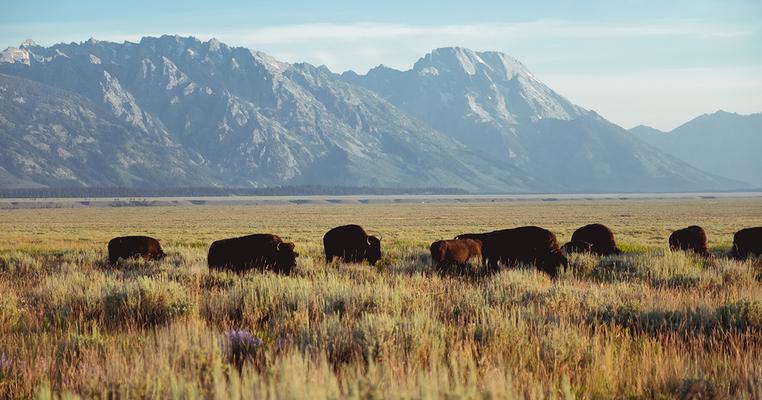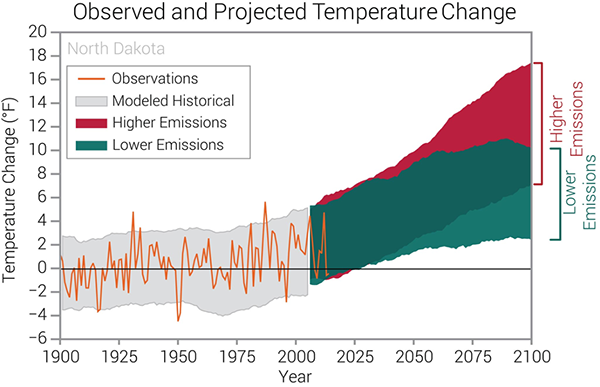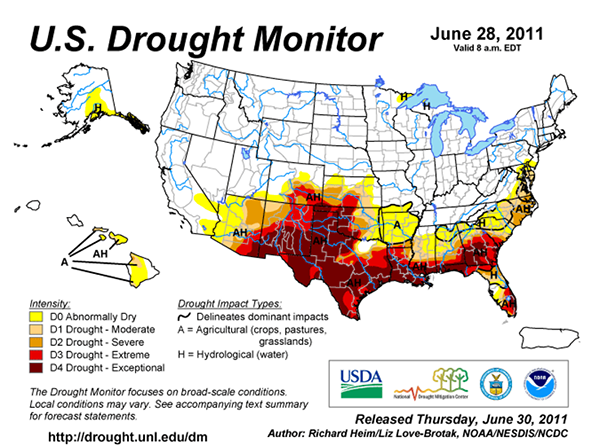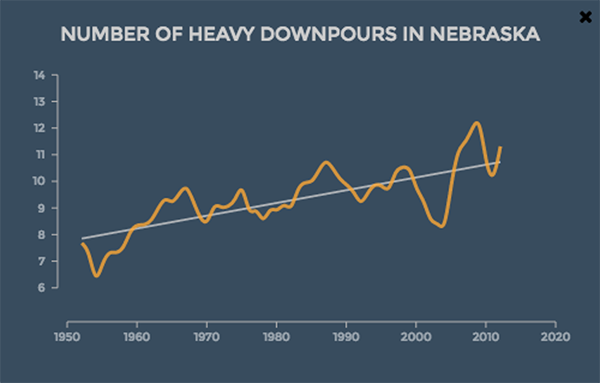
How Is the Climate Crisis Affecting the Great Plains?
The Great Plains is a vast region of the central United States – so vast, in fact, geographers and researchers sometimes split it into two or three subregions. For our discussion here, the Northern Plains includes Montana, Wyoming, Nebraska, North Dakota, and South Dakota; whereas the Southern Plains are made up of Texas, Oklahoma, and Kansas. (Some researchers actually include parts of southern Canada and even northern Mexico in their studies of this region, but we’ll be focusing on the conventionally accepted geographic boundaries of the region.)
These eight states span thousands of miles and include many different ecosystems, from sprawling grasslands to the foothills of the Rockies. From state to state, residents experience a huge variety of climates and weather, but the fingerprints of climate change are everywhere, transforming lives and livelihoods and the very ground beneath their feet.
Rising Temperatures
Here’s the climate reality: Although each state in the Great Plains has experienced a different level of warming, all are seeing rising average temperatures. Montana, Kansas, and North Dakota have seen some of the greatest temperature rises since the early 1900s.
If you live in Texas, you know it’s often pretty hot in the state. And if you live in North Dakota, you know that it can be bitterly cold. And if you haven’t been to either, it probably still makes sense that the climate tends to be colder in the north and warmer in the south. Similarly, there are also big differences in the eastern parts of the Great Plains versus the western parts. But across the board, the Great Plains region is seeing higher and higher temperatures thanks to climate change.
In fact, according to the National Oceanic and Atmospheric Administration (NOAA), “North Dakota has experienced one of the largest temperature increases on any contiguous US state.”
Winters in North Dakota are drastically warmer than they once were. Compared to 130 years ago, the season has warmed 4.4 degrees Fahrenheit per century, on average. Oklahoma, on the other hand, has seen less than 1-degree Fahrenheit of warming of its annual temperatures overall.

“Observed and projected changes (compared to the 1901–1960 average) in near-surface air temperature for North Dakota.” (Image courtesy NOAA)
NOAA describes what the future may hold for all eight Great Plains states if we don’t act: “historically unprecedented warming.” Even under a low-emissions scenario, the Northern Plains could be 2 to 4 degrees warmer in just the next 30 years – which scientists expect “to result in an increase in the occurrence of both drought and heat waves.”
It can be easy to think that temperatures rising a few degrees is no big deal, but even a seemingly small change in temperature can make a big impact on our lives. We rely on stable, long-established temperature patterns for our crops, our health, and our economies.
The economy of the Northern Plains is heavily dependent on agriculture, making up nearly a quarter of America’s cropland at more than 200 million acres. For the entire Great Plains region, agriculture actually takes up a whopping 80 percent of land area. Even though farmers are used to riding out good years and bad years, climate change is making their work harder than ever. Rising temperatures and heat waves, for example, reduce crop yields and create stress on livestock.
And don’t forget the health implications. Climbing temperatures are dangerous, especially for farmworkers and other people who work outside. Extreme heat is profoundly dangerous to the human body because it challenges our ability to regulate a safe internal temperature. Hotter temperatures can also mean increased ranges and longer seasons for mosquitoes and other vectors that carry disease, putting public health at even greater risk.
Powerful, visceral reporting here. For farmworkers in places like Rio Grande valley climate change means "a hard day's work is getting hotter," more dangerous https://t.co/QxQOwTC4S0 via @scottpwaldman
— Fred Krupp (@FredKrupp) January 11, 2019
Drought
Here’s the climate reality: Temperature and precipitation are inextricably linked because rising temperatures intensify the water cycle. Overall, Great Plains states are expected to experience more intense droughts as the climate changes.
In 2017, the Northern Plains were hit hard by drought — “desiccating pastures, rangelands and wheat, sparking massive wildfires, and causing widespread livestock sell-offs” and costing the region $2.6 billion in losses. Research from NOAA and CIRES indicates that human-caused climate change made that intense a drought up to 20 percent more likely.
The Southern Plains is no stranger to extreme drought either. In June of 2011, nearly the entire subregion was in a drought, with most of it was categorized as “exceptional.”

While the impact of drought on agriculture and farmers is well-known, it’s also important to remember that water scarcity impacts our power grid. For example, the 2011 drought shut down power plants in places like Texas. The vast majority of the world’s electricity is generated by boiling water to create steam that spins turbines. Fossil fuel power plants are especially thirsty, so when water is in short supply, these plants easily can’t operate.
>>Related: A Thirst for Power: The Water-Energy Nexus<<
Flooding
Here’s the climate reality: Though the region is expected to get drier with climate change, when rain or snow does come, it’s expected to be more intense — creating the potential for big floods.
For both the Southern and Northern Plains, extreme precipitation is expected to become more likely with climate change. You might be wondering: Wait, weren’t we just talking about drought?
While much of the Great Plains are expected to get drier overall, when precipitation does fall, it’s likely to be more intense – especially in the winter and spring – arriving quickly and at a high volume. And when all that water hits parched land, it runs off rather than being absorbed by the soil, sending rivers over their banks, overwhelming city sewage systems, eroding farmland, and much more.
As our atmosphere becomes warmer, evaporation from the surface increases and the air can hold more and more water vapor. This can spell disaster when all that water gets unleashed at once. To see what the future may hold for the region, we can look at what happened in Nebraska and Iowa in March of 2019. That month, those states were hit hard by devastating floods that also tore through Midwestern states like Illinois, Missouri, Wisconsin, and Indiana.

The number of heavy downpours in Nebraska has been steadily increasing since the 1950s due to climate change. (Graph courtesy of Climate Central’s State’s at Risk program)
A series of strong storm systems, including a so-called “bomb cyclone”, dropped heavy rain (and snow) on Nebraska and the resulting floods killed several people and caused an estimated $1 billion in damages to homes, infrastructure, and crops. As Governor Pete Ricketts said at the time, "I don't think there's ever been a disaster this widespread in Nebraska."
When asked about climate change and the future, Nebraska state climatologist Martha Shulski had this to say to the Omaha World Herald: “Is our risk going to be greater? Yes, because these events (drought, flood, heat waves) are going to become more common. The better question is ‘How prepared are we?’”
Peru, Nebraska has seen plenty of 100-year and 250-year floods, but this is unlike anything they've ever experienced before. Our coverage on the massive midwestern flood story continues throughout the day. pic.twitter.com/n4aSkuX3Ud
— The Weather Channel (@weatherchannel) March 20, 2019
Here’s What You Can Do
It’s clear: the climate crisis is an enormous problem that requires all of us to take bold action, in the Great Plains and around the globe.
To learn how to get started, download our latest (free!) e-book, What Can You Do? Your Guide to Climate Action in 2020.
The impacts of the climate crisis may be far-reaching, but here’s the good news: solutions exist right now that can help us improve quality of life and work toward a more sustainable future for all of us.
And you are key to making those solutions a reality. Download this free new resource and learn how to shape climate action and drive change in your community today.

